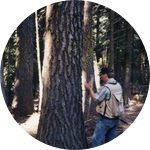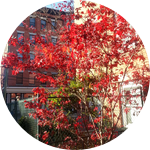About This Project
Biodiversity of plant species is thought by many to be essential to forest function and health. But what elements of forest structure are most important to species diversity? How do microclimate variables like temperature, evapotranspiration and photosynthetically active radiation interact? I'm a graduate student focused on developing spatio-temporal models that characterize forest structure and enable forest measurements to be analyzed to aid in forest policy making decisions.
Ask the Scientists
Join The DiscussionWhat is the context of this research?
The fundamental question I am trying to answer is, "How does forest canopy structure impact biodiversity?". This is an important forest policy discussion as well, as microclimate and incident solar radiation impact plant habitat suitability.
Biodiversity is a measure of species richness and abundance in an ecological community. My statistical modeling will test spatially explicit sets of related data forest data and suggest patterns of canopy structure that, all things being equal (soils, precipitation, evenness of plant species disperal, etc.) provide the natural ideal for plant biodiversity in a given forest habitat.
What is the significance of this project?
Although most of the Earth’s biodiversity is found in its oceans, the World Wildlife Fund has estimated that over 80% of the terrestrial biodiversity on the planet is derived from its remaining forests. Forest ecosystems are thought by many ecologists to offer greater niche habitats and genetic composition that support overall species richness and abundance through both spatial structure and patch patterns, as well as through temporal changes caused by natural disturbance regimes, than other terrestrial ecosystems. The structure of the forest itself, therefore, with respect to its canopy structure, its 'temporal' or 'sucessional' phases, in addition to its associated landscape patterns, may yield significant insights into where and how biodiversity is most likely to be prevalent.
What are the goals of the project?
This research will hopefuly be useful to aide in informed forest policy decision making, but the near term goals also include providing stand structure data to managers to support stand management in an urban-wild-land interface. What structural characteristics can be identified that maintain microrefugia for flora and fauna undergoing ecosystem-wide stresses, associated with changes in primary productivity, biogeochemical nutrient flux, habitat loss, and other heightened natural disturbance factors such as fire and pathogens? A strong statistical, ecological and biogeographical framework for modeling will be required. I have and hope to continue to collaborate with many research partners to develop research products.
Budget
Travel for biodiversity transect survey 340 miles from the lab is budgeted, requiring rental vehicles or maintenance and fuel for personal vehicles. Two trips to a fairly remote location are required, but lodging has been provided.
The first two visits (2016 and 2017) included site selection, biodiversity survey preparation and forest structure survey. The last two (2018) will include the completion of biodiversity ~70 sampling plots to complete modeling development and the thesis defense.
Endorsed by
 Project Timeline
Project Timeline
The remaining work is fieldwork (survey and plant species identification) and lab analysis (regression modelling in IBM SPSS, spatial analysis in ArcGIS Pro)
Jun 20, 2016
Project Launched
Jun 28, 2016
Project Launched
May 31, 2018
Complete geospatial data analysis and filed protocol (SFSU Lab)
Jun 23, 2018
Travel to Russian Wilderness (KNF, CA)
Jul 07, 2018
Travel to Russian Wilderness (KNF, CA)
Meet the Team
Affiliates
Team Bio
Paul is a Graduate Student of Biogeography at San Francisco State University working with guidance from both the university, local forest ecologists and the John Muir Project.
Helene Ehling is a law student in Amsterdam, Netherlands. She will perform financial administration for the research project, including approval of expense requests as per published budget guidelines and collection of receipts as well as posting purchased items to the lab notes in an equipment list.
Paul C Dunn
Forest life sciences have been a research interest of mine since my first experience in Pacific salmon stream restoration in the late 1980's. Since that time I have gained experience in wildlife population and habitat surveys, forest ecology and management, and ecological economics. This project and my proposed field work is a culmination of both work and research experiences, and when completed, I hope to pursue my PhD and work on global forest preservation issues. I am a graduate student of Geographic Information Sciences with an orientation toward biogeography and forest ecology. My background includes contributing to wildlife studies in the Altai Ecoregion of the Russian Federation, specifically monitoring surveys of Siberian Snow Leopard, Altai Argali and Siberian Ibex, and in the Klamath Ecoregion of Southern Oregon and Northern California for Northern Spotted Owl, Pacific Fisher and American Pine Marten population and habitat surveys. My forest research interests have taken me to the Olympic Peninsula in Washington State, the Kenai Peninsula of Alaska, Yellowstone and Grand Teton National Parks in Montana, and Wyoming, Fiordland National Park, New Zealand, and the Sierra Nevada in California. My field experience includes several years of forestry in Northern California. My current study extent is located in and adjacent to the Russian Wilderness in the Klamath National Forest, an area with the highest known conifer biodiversity in North America.
Helene K. Ehling
From an early age, I have had a love for traveling and discovering the beauty of nature. I feel that Paul's research project will nurture sustainable forest policy-making and development, conservation efforts and quality of life for all living beings. Therefore, I am happy to be the project treasurer, ensuring accountable disbursement processing as well as transparent expense reporting.
Additional Information
A report issued by The Wilderness Society titled "Federal Forests and the Economic Base of the Pacific Northwest", with contributors from the Brookings Institution and many regional universities, discusses the ecological significance of regional biodiversity in my study area as a functional aspect of healthy forests. It states that "Biodiversity represents an interplay of three fundamental qualities of ecosystems: composition, structure and function. Composition includes the kinds of species present and their variety and abundance. Structure refers to physical habitats and components such as [vegetation layers", and function "includes various ecological and evolutionary processes, such as nutrient cycling, [genetic diversity] and [species] adaptation."
"The [Pacific Northwest] ancient forests provide a home for a rich and varied complement of biological diversity." and its soils "may contain the highest levels of terrestrial diversity in the world." "Among the remarkable features of the Klamath region are its geological antiquity and its extremely rich diversity of plant species, including the most species of conifers anywhere on earth." We want our basic research to quickly move to applied research benefiting forest policy and conservation decision making. Management ecologists and National Science Foundation reviewers we have discussed our work with share our enthusiasm. It is important to remember that the national forests are the "people's forests", and as such, their vitality is dependent, as it always has been historically, on public interest advocacy to to guide federal land management policy.
Why the wilderness and thesis details.
My interest is in conducting basic research that yields results applicable to applied research technology development. But why study a wilderness forest that is already protected? The primary reason is to establish a baseline of natural forest states that show how biodiversity occurs in nature. The wilderness area selected has been protected since the 1980's and is roadless.
The primary human (anthropogenic) impacts to the area are fire suppression and grazing. Since many meadow habitats in the Northern California region are in dire need of restoration, they are purposely being excluded from the study plots although they represent high potential biodiversity in a healthy state. The other types of plots that will be studied are wilderness fire disturbances (high potential biodiversity after 3-5 years post-fire) and adjacent timber harvest areas on public land.
Thesis Research Topic: Analysis for
The objective would be the development of a regression meodel of independent structural variables that impact measures of biodiversity, i.e., richness and abundance, functional as well as taxonomic. This would increase the understanding of forest ecosystem services as they relate to structure over areas where a field survey approach would not be feasible or not likely to provide an accurate or cost-effective result relative to the use of remotely sensed data on a regional scale. The level of biodiversity data will be very comprehensive and robust, but limited to primary producers (vascular plants), lichens and bryophytes.
The models will use the best available metrics published by NASA and affiliated remote sensing labs. These mesure LiDAR data and model canopy structure. The model will also use leaf area index data taken from a WorldView2 multispectral image taken from a satelite born sensor, and incident solar radiation of the canopy surface derived from a digital elevation model (DEM).
Ultimately, a research product will be released designed around a single ecological community that can be scaled up to model areas for complex biodiversity studies.
Project Backers
- 9Backers
- 59%Funded
- $2,431Total Donations
- $42.33Average Donation



